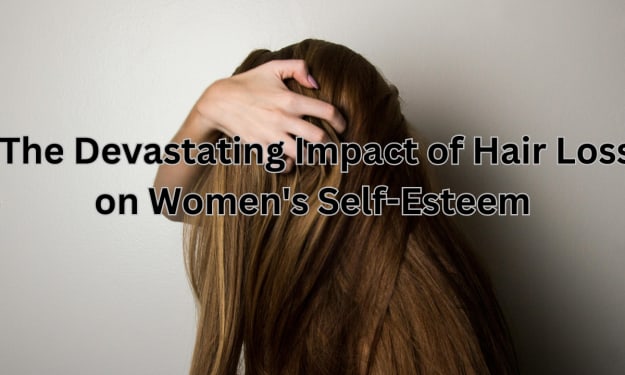Content warning
This story may contain sensitive material or discuss topics that some readers may find distressing. Reader discretion is advised. The views and opinions expressed in this story are those of the author and do not necessarily reflect the official policy or position of Vocal.
HIGH RISK SEXUAL BEHAVIOURS
Engaging in high-risk sexual behavior exposes individuals to sexually transmitted infections (STIs), unplanned pregnancies, and the challenges of navigating sexual relationships without the maturity or knowledge needed for a healthy relationship. Adolescents and young adults are particularly vulnerable compared to older adults.

IF YOU NEED SEX PERFORMANCE INCREASE MEDICINE, CLICK HERE
High-Risk Sexual Behavior: An Overview
Engaging in high-risk sexual behavior can lead to numerous adverse outcomes, including sexually transmitted infections (STIs), unplanned pregnancies, and complications in navigating sexual relationships without sufficient maturity or knowledge. Adolescents and young adults are particularly susceptible to these risks compared to older adults, due to a variety of factors including biological, social, and psychological influences.
Examples of High-Risk Sexual Behavior
- Unprotected Intercourse: Engaging in vaginal or anal sex without using male or female condoms increases the risk of STIs and unplanned pregnancies.
- Unprotected Oral Sex: Oral-genital contact without protection can transmit infections such as herpes, gonorrhea, and HPV.
- Early Sexual Activity: Initiating sexual activity at a young age is associated with a higher likelihood of contracting genital herpes and other STIs, as well as other negative outcomes such as emotional distress.
- Multiple Sexual Partners: Having several sexual partners over a short period increases the risk of exposure to STIs.
- High-Risk Partners: Engaging with partners who have multiple sexual partners or engage in other high-risk behaviors heightens the risk of STIs.
- Unprotected Anal Sex: Both giving and receiving unprotected anal sex significantly increase the risk of STIs, including HIV.
- Partners Who Use Drugs: Having sex with partners who inject drugs can increase the risk of bloodborne infections like HIV and hepatitis.
- Sex Trade Work: Engaging in or with sex work involves a higher exposure to risky sexual situations and potential STIs.
Reasons for High-Risk Behavior
- Lack of Awareness: A limited understanding of the risks associated with STIs and their modes of transmission.
- Poor Communication: Inability or reluctance to discuss safer sex practices with sexual partners.
- Inadequate Preparation: Not being prepared or knowledgeable about how to effectively use protection.
- Unawareness of Symptoms: Many STIs have subtle or non-existent symptoms, leading to unintentional transmission.
- Reluctance to Seek Care: Fear, stigma, or embarrassment that prevents individuals from seeking medical attention for STI symptoms.
- Limited Access to Treatment:L Economic or geographic barriers that restrict access to affordable STI testing and treatment.
- Substance Use: Alcohol and drug use can impair judgment, increasing the likelihood of engaging in unsafe sex.
- Peer Pressure: Social pressures can compel individuals to engage in sexual activities without proper safety measures.
- Misinformation: Receiving and believing incorrect information about sexual health, contraception, and STIs.
- Low Self-Esteem: Individuals with low self-esteem may not feel empowered to insist on safe sex practices.
- Cultural and Social Influences: Societal norms and cultural beliefs can shape attitudes toward sex and safe practices.
Preventive Measures
To mitigate the risks associated with high-risk sexual behavior, a multifaceted approach is essential. This approach should involve education, access to healthcare, and fostering a supportive environment that encourages safe practices and informed decisions.
Comprehensive Sex Education:
- STIs and Contraception: Educate about various STIs, their symptoms, and prevention methods, along with detailed information on different types of contraception.
- Healthy Relationships: Promote understanding of healthy, consensual relationships and the importance of mutual respect and communication.
Access to Protection:
- Condoms and Other Protection: Ensure condoms and other protective measures are readily available and affordable.
- Barrier Methods: Educate on the use of dental dams for oral sex to reduce STI transmission.
Encourage Communication:
- Open Discussions: Promote the importance of discussing sexual health and safe practices with partners.
- Consent Education: Teach about the importance of consent and respectful communication in sexual relationships.
Regular Health Check-Ups:
- STI Testing: Encourage regular testing for STIs, especially for those with multiple partners.
- Medical Consultations: Promote routine visits to healthcare providers for sexual health concerns.
Support Services:
- Substance Abuse Support: Provide resources and support for individuals struggling with substance abuse, which can impair judgment and lead to risky behaviors.
- Mental Health Services: Offer mental health support to address underlying issues that may contribute to risky sexual behaviors.
Empowerment Programs:
- Self-Esteem Building: Implement programs aimed at boosting self-esteem and decision-making skills, particularly targeting young people.
- Skill Development: Teach negotiation and assertiveness skills to empower individuals to make safer choices.
Policy and Community Support:
- Public Health Campaigns: Launch public health campaigns to raise awareness about the risks of high-risk sexual behavior and the importance of prevention.
- Community Involvement: Engage community leaders and organizations in promoting sexual health education and resources.
Conclusion
Addressing high-risk sexual behaviors requires a comprehensive and coordinated approach. By combining education, healthcare access, and supportive environments, we can significantly reduce the risks and promote healthier sexual practices. Empowering individuals with knowledge, resources, and support is crucial in fostering informed and safe sexual behaviors.
IF YOU NEED SEX PERFORMANCE INCREASE MEDICINE, CLICK HERE
About the Creator
william jane
EXPERT FOR HEALTH & FITNESS
Enjoyed the story? Support the Creator.
Subscribe for free to receive all their stories in your feed. You could also pledge your support or give them a one-off tip, letting them know you appreciate their work.






Comments
There are no comments for this story
Be the first to respond and start the conversation.